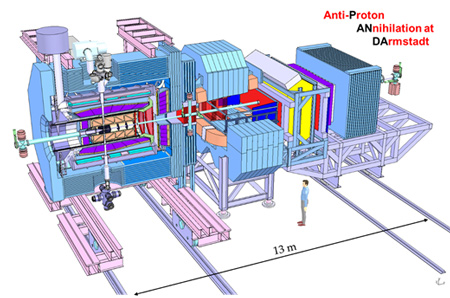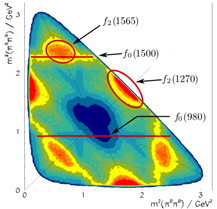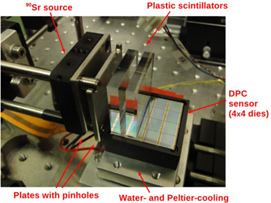The PANDA Experiment
The PANDA Experiment is one of the large scale projects at FAIR. It will study antiproton annihilations on nucleons and nuclei in the energy range of strange and charmed hadrons. A synchrotron and storage ring (HESR) will provide an antiproton beam with very small momentum spread (2x10-5) or high luminosity (2x1032 cm-2s-1). The commissioning of the experiment at FAIR is planned to start in 2020.

PANDA physics pillars
Hadron Spectroscopy
Search for Gluonic Excitations: One of the main challenges of hadron physics is the search for gluonic excitations, i.e. hadrons in which the gluons can act as principal components. These gluonic hadrons fall into two main categories: glueballs, i.e. states where only gluons contribute to the overall quantum numbers, and hybrids, which consist of valence quarks and antiquarks as hadrons plus one or more excited gluons which contribute to the overall quantum numbers.

Charmonium Spectroscopy: The charmonium spectrum can be calculated within the framework of non-relativistic potential models, EFT and LQCD. All 8 charmonium states below open charm threshold are known, but the measurements of their parameters and decays is far from complete (e.g. width and decay modes of hc and ηc(2S)). Above threshold very little is known: on one hand the expected D- and F- wave states have not been identified (with the possible exception of the ψ(3770), mostly 3D1), on the other hand the nature of the recently discovered X, Y, Z states is not known.
D Meson Spectroscopy: The recent discoveries of new open charm mesons at the BaBar, Belle and CLEO has attracted much interest both in the theoretical and experimental community, since the new states do not fit well into the quark model predictions for heavy-light systems in contrast to the previously known D states. An important quantity which allows to distinguish between the possible different theoretical pictures is the decay width of these states (in particular the Ds states).

Nucleon Structure
Generalized Parton Distributions: The theoretical framework of Generalized Parton Distributions (GPDs) has recently been developed and caused excitement in the field of understanding the structure of the nucleon. It has recently been shown that exclusive pp annihilation into two photons at large s and t can be described in terms of GPDs.
It is proposed to measure the crossed-channel Compton scattering and the related exclusive annihilation processes with a scalar meson, a vector meson, or a lepton pair in the final state. The comparison of the differential cross sections for the various processes and the comparison with GPD based models will allow new insights into the annihilation process in terms of quark models and QCD.
Time-like Form Factor of the Proton: The electromagnetic form factor of the proton in the time-like region can be extracted from the cross sections for the process pp → e+ e-. The proton time-like form factors have been measured by several experiments in the low Q2 region down to threshold. At high Q2 the only measurements have been achieved by E760 and E835 at Fermilab up to Q2 of 15GeV2/c2. However, due to limited statistics |GM| and |GE| have not been measured separately and could only be extracted using the assumption |GE| = |GM|. In PANDA, it will be possible to determine the form factors over the widest Q2 range with a single experiment, from threshold to 20 GeV2/c4 and above, depending on the beam time availability. Due to much improved statistics and angular coverage it will be possible to significantly improve the results of E760 and E835 and to measure |GM| and |GE| separately.

Hadrons in Matter
The study of medium modifications of hadrons embedded in hadronic matter is aimed at understanding the origin of hadron masses in the context of spontaneous chiral symmetry breaking in QCD and its partial restoration in a hadronic environment. So far experiments have been focused on the light quark sector. The high-intensity p beam of up to 15 GeV/c will allow an extension of this program to the charm sector both for hadrons with hidden and open charm. The in-medium masses of these states are expected to be affected primarily by the gluon condensate.
Another study which can be carried out in PANDA is the measurement of J/ψ and D meson production cross sections in p annihilation on a series of nuclear targets. The comparison of the resonant J/ψ yield obtained from p annihilation on protons and different nuclear targets allows to deduce the J/ψ -nucleus dissociation cross section, a fundamental parameter to understand J/ψ suppression in relativistic heavy ion collisions interpreted as a signal for quark-gluon plasma formation.

The SMI activities in the PANDA project are contributions to the software framework and simulations/analysis, involvement in the development of the PandaGrid computing network and maintenance of a PandaGrid site, as well as R&D for different detector parts.
The hardware activities are concentrated on the development of a prototype sensor for the SciTil detector (Scintilation Tile Hodoscope). The SciTil is a timing detector and is planned to be mounted in front of the Electromagnetic Calorimeter (EMC). It is made of ~ 3 x 3 x 0.5 cm³ scintillator tiles matching the front face of the EMC crystals, and will be read out by 3 x 3 mm³ Silicon Photo Multipliers (SiPMs). A test setup to measure the time resolution of such scintillation tiles is shown below.
The presence of a large magnetic field due a solenoid magnet prohibits the use of PMTs. At SMI a prototype of a scintillating tile with SiPM readout was investigated and it was demonstrated to provide a time resolution below 100 ps.
In addition SMI is involved in studies of the (hydrogen) cluster-jet target of PANDA. A continuous working of the cluster-jet beam, without blocking due to freezing of impurities in the nozzle, is essential for the use in PANDA. Therefore, a gas purification system in the sub-ppm region is absolutely necessary.

SMI is performing R&D work to develop such a purification system which has to work at high gas throughput and at high pressure to achieve the required cluster-jet density for PANDA. In addition, first studies have been started for the design of a closed-cycle deuterium gas system.
